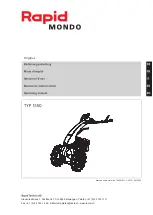
Exhaust and Ventilation Requirements
The NexION 300 ICP-MS has two separate exhaust ports.
Both of the NexION 300 ICP-MS exhaust ports are located
on the top of the instrument (see Figure 6). The torch box
exhaust port is located 46.5 cm (18.5 in.) from the right side
of the instrument. The RF generator exhaust port is located
67.5 cm (27 in.) from the left side of the instrument.
The torch box exhaust port exhausts the following:
• Plasma heat and fumes
• Vacuum pump exhaust – including cell gases on Universal
Cell Technology
™
(UCT) instruments
• Cell gas assembly manual vent/purge switch
The torch box exhaust venting system is required to remove
combustion fumes and vapors from the torch housing, and
to remove reaction cell gas. Exhaust venting is important for
four reasons:
• It protects laboratory personnel from toxic vapors that
may be produced by some samples.
• It minimizes the effects of room drafts and the laboratory
atmosphere on ICP torch stability.
• It helps protect the instrument from corrosive vapors
which may originate from the samples.
• It removes dissipated heat which is produced by the ICP torch.
The torch exhaust port always has 0.5 inches of water (125 Pa)
static pressure. The RF generator exhaust port has 0.5 inches
of water (125 Pa) static pressure when the plasma is off –
during operation, the static pressure drops to zero. Both of
the exhaust ports should be connected directly to flexible
exhaust hoses. Use the vent adapter to attach the roughing
pump exhaust hose to the torch box exhaust port.
Table 5. Electrical Requirements for NexION 300 ICP-MS
Peripherals.
Equipment Voltage(AC) Power
Computer
100-127V/200-240V,
800W
50/60Hz
typical
Printer
100-127V/220-240V,
800W
50/60Hz
typical
Roughing Pump
200-240V, 50/60Hz 12A 1500W
Cooling System:
Heat Exchanger
208-240V, 50/60Hz
660W
(PolyScience
®
3370) 120V, 60Hz 5.5A
or
Refrigerated chiller
208-230V, 60Hz 12.2A
2500W
(PolyScience
®
6106PE) 240V, 50Hz 12.2A
Mains Connection
The instrument is shipped with one 2.4 m (8 ft.) mains cord
terminated by an IEC 60309 connector rated 30A by UL (North
America) and 32A by VDE (International) for 250V as shown in
Figure 5.
6
Figure 5. IEC 60309 connector.
Figure 6. Location of exhaust ports.
EXPLOSIVE ATMOSPHERE. The use of ICP-MS
instruments without adequate ventilation to
outside air may constitute a health hazard.
For example, the combustion of halogenated
hydrocarbons produces toxic vapors. When
ammonia is used as a Dynamic Reaction Cell
gas, it can be present at very trace amounts
in the exhaust during purging of the gas lines.
Extreme care should be taken that exhaust
gases are vented properly.
!
WARNING
67.5 cm
(27 in.)
46.5 cm
(18.5 in.)
RF Generator
Exhaust Port
Torch Box
Exhaust Port



























